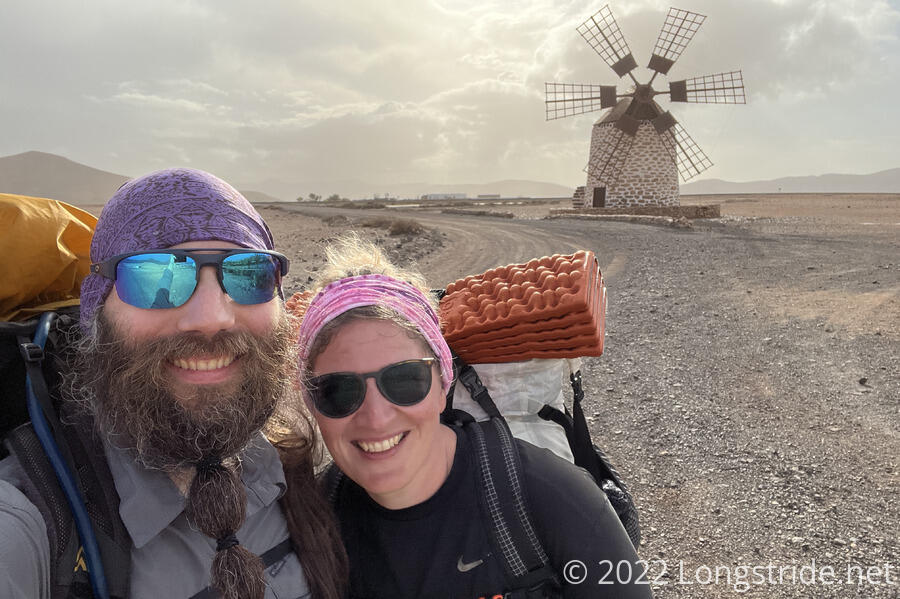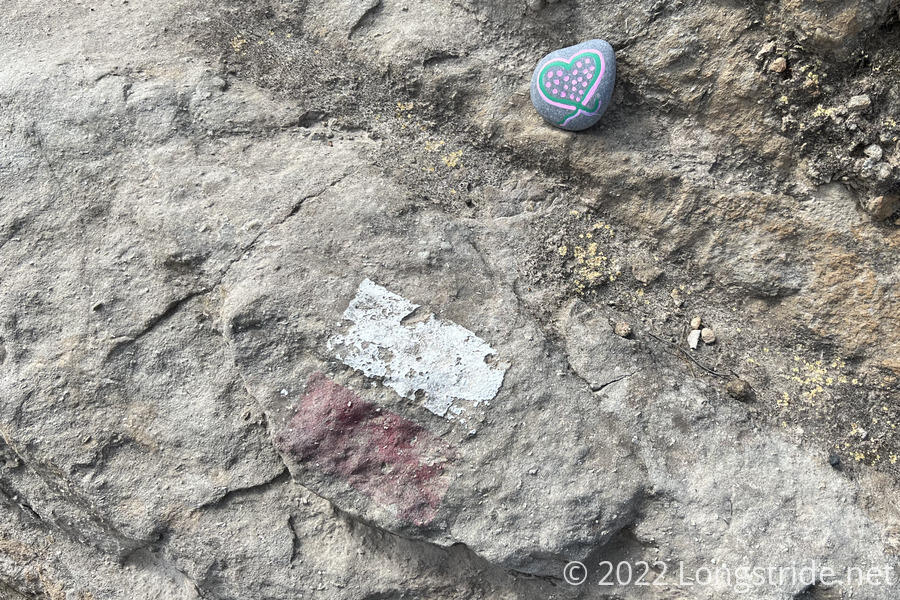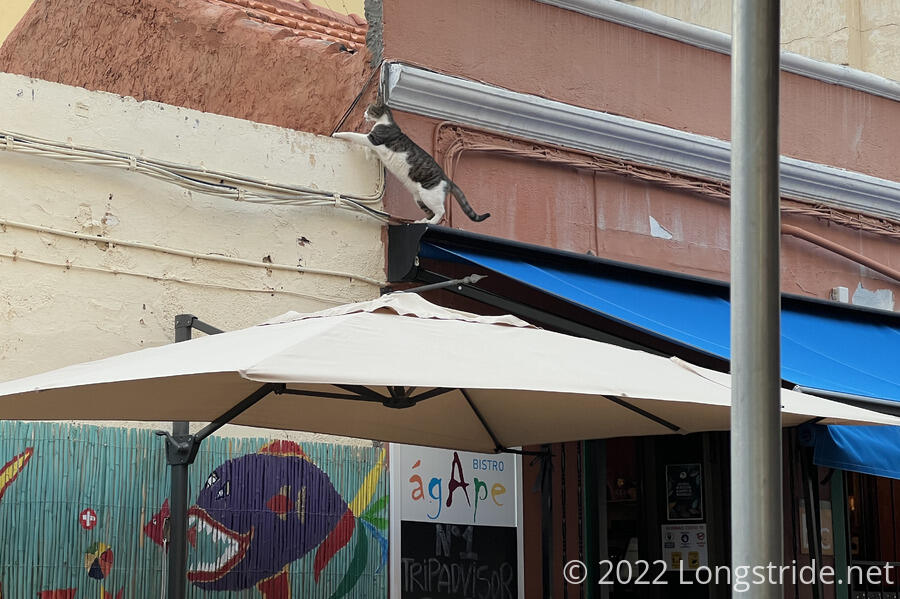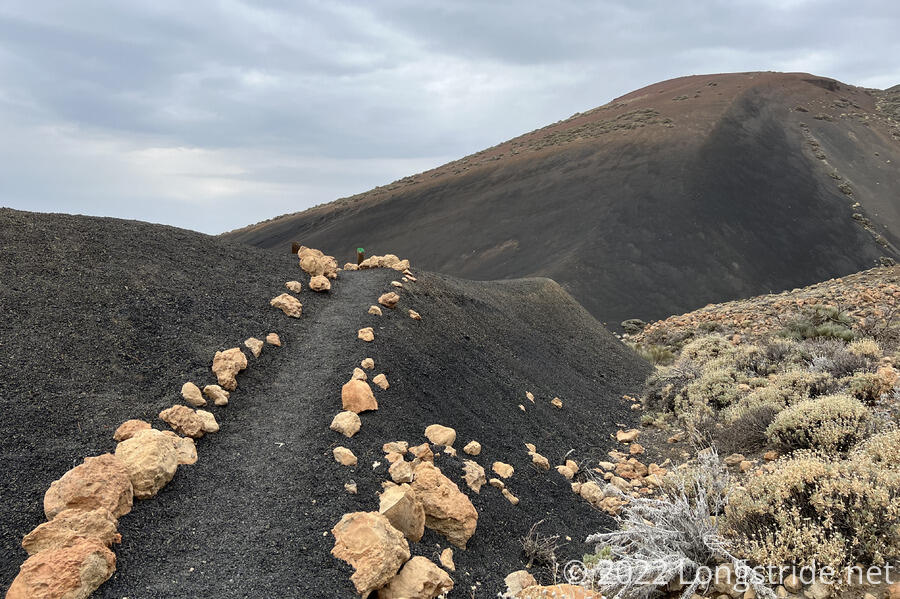I think the best way to hike a trail is to have as few preconceived notions as possible of what the trail will be like. Being too certain of what the trail will bring makes it easy to be disappointed, when the trail (or circumstances) causes something different to happen. But that philosophy has to be tempered with understanding the general reality of the trail you’re hiking, and that’s where we didn’t fully appreciate the challenges of hiking in the Canary Islands until after we got there.
Being long-distance thru-hikers, CareFree and I attempted to approach the GR 131 as our other long-distance hikes. But the trail isn’t really designed to be hiked that way, and that led us to a lot more stress than was both anticipated, or necessary.
Planning the Hike
Largely, wild-camping is not allowed on the Canary Islands. Even so, we took all of our camping gear — tent, sleeping bags, water filter, etc — “just in case”. And while we did manage to make use of the tent once, and our sleeping bags three times, with a little more work up-front to identify places in town to stay, it might have been possible to not bring them at all. It certainly would have been a lot easier to hike with several pounds less gear.
Our choice of timing did not help in that regard. By hiking during heightened restrictions due to the ongoing coronavirus pandemic, there were fewer places to stay in town than usual. We also didn’t plan very far ahead. That’s fine for an “ordinary” thru-hike, but with the GR 131 being very much designed around being a series of day-hikes based out of towns, not spending time before the hike to fully familiarize ourselves with the situation (beyond a simple “yes, this looks possible”) meant that we had to spend a lot of time while in town planing everything out.
We were on the trail for 29 days. Of that time, we had only one day where we weren’t either hiking, traveling to the next island, or both. This zero, our last day on Gran Canaria, wasn’t especially relaxing because we had to spend several hours planning out Tenerife. We might have physically relaxed, but mental relaxation is just as important on a thru-hike, and we didn’t get nearly as much as we’d have liked.
Fortunately, there were two of us hiking together. Hiking with CareFree allowed a lot of teamwork when planning out each island, and let us get the work done a lot faster than if it had been just one of us.
Staying in town almost every night on the trail made this hike relatively expensive per mile. Fortunately, we had two people splitting the costs, which kept the hike somewhat affordable.
Connection to the Trail
On most of the islands, we were tethered to the island’s bus system and/or had to use taxis (especially on La Palma and El Hierro), and stayed in towns remote from the trail. This made me feel much less connected to the trail than I usually feel on long-distance hikes, where it’s easy to camp on the trail most evenings, and towns are either on-trail or relatively close by, and in either case, are an occasional “treat”, as opposed to a destination every evening. The time traveling by bus (usually at least an hour and a half each day it was required, if not more) was not especially restful, as we had to stay alert to keep track of where we were (or that someone wasn’t making off with our packs when we had to stow them under the bus), especially when transfers were required.
I wouldn’t necessarily say that this reduced my enjoyment of my hike, but it did require getting into a different mindset and accepting that GR 131 would not be like the other trails I’ve hiked in that regard. Even once we accepted this, dealing with towns was mentally draining. We couldn’t do things on our schedule; instead, we had to wake up and go according to when the bus or ferries ran.
Food and Water
My stove and cooking equipment was the least useful gear on this hike. The fuel canisters we needed to use our stoves were simply not available in the Canaries; the canisters available had the right fuel, but wrong connection method, and we had no adapters. (We couldn’t just bring fuel with us to the islands since it’s not allowed on airplanes). Fortunately, we passed through small towns at least once (and often several times) a day that had stores (or restaurants) where we could buy food and water. Cooking on-trail was entirely not necessary, and all of the food I’d brought to cook on-trail wound up getting used in town instead.
It was quite refreshing to be able to only carry a day’s worth of emergency food supply, and buy fresh food when we passed through town. We came to enjoy our short ice-cream-and-soda breaks.
My water filter was the second least useful piece of gear. Thanks to the towns on trail, we could buy all the water we needed, no filtering necessary. (Bottled water was fairly inexpensive, since that’s where most people on the islands get their drinking water from; tap water is desalinated, and of dubious quality for drinking.) Also, partially due to the trail’s largely-on-road design, and partially due to the season, there wasn’t a single drop of flowing water anywhere on the trail. However, I’m still glad I had my filter, just in case of an emergency.
Weather
The weather was absolutely wonderful, setting aside the several days when a calima (windswept Sahara sand) was blowing through. Temperatures generally were perfect for hiking, and there was rarely much humidity. The only bad weather we had were rain on La Palma one day, and then freezing weather with high winds the following day. While we occasionally had to hike through fog, aside from that, it was generally clear out with sunny skies. It was an excellent respite from what would otherwise have been a cold, snowy winter back home.
Random Thoughts
On my US-based thru-hikes, it was easy to tell you were approaching town because you could hear the sound of cars on the road. In the Canary Islands, the sound of an approaching town was either farm animals (usually roosters) or barking dogs.
You almost couldn’t go anywhere in a town without hearing dogs barking. This was not surprising, given the islands’ namesake. (The Spanish Islas Canarias is derived from the Latin Canariae Insulae, meaning “Islands of the Dogs”.) But also, nearly every town we visited had stray cats roaming around. I don’t think I’ve ever seen so many stray cats before.
The trails in general were very well marked, and very well maintained. I think there were perhaps only one or two blowdowns we had to walk around, and we only went off-trail accidentally once, when there was a turn at a shelter and we got distracted.
Future Plans
We very much want to return to the Canary Islands. Summiting El Teide is very high on our list of things to do, as is completing the trail on La Palma. I wouldn’t mind returning to Fuerteventura and re-hiking the sections where we couldn’t see anything due to the sand in the air. And there’s more trails on the islands besides that; both La Gomera and La Palma have trails that circle the islands (the GR 132 and GR 130, respectively) that might be fun to do. And, of course, we have to return to Gran Canaria to visit our friends and enjoy the excellent papas arrugadas con mojo. We don’t know when we’ll make it back to the islands, but we’re definitely going back.



